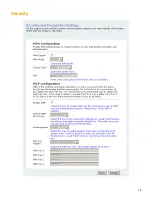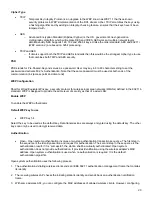
20
Cipher Type
•
TKIP
o
Temporal Key Integrity Protocol is an upgrade to the WEP known as WEP 1.1 that fixes known
security problems in WEP’s implementation of the RC4 stream cipher. TKIP scrambles the keys using
a hashing algorithm and by adding an integrity-checking feature, ensures that the keys haven’t been
tampered with.
•
AES
o
Advanced Encryption Standard (Rijndael Cypher) is the U.S. government's next-generation
cryptography algorithm, which will replace DES and 3DES. AES works at multiple network layers
simultaneously. AES Supports 128, 192 and 256 bit keys. Unlike the older standard, AES and 802.11i
(WEP version 2) are based on 32bit processing.
•
TKIP
and
AES
o
If clients support both the TKIP and AES standards then this would be the strongest cipher type to use
that combines both TKIP and AES security.
PSK
PSK stands for Pre-Shared-Key and serves as a password. User may key in 8 to 63 characters string to set the
password and activate 802.1x Authentication. Note that the same password must be used at both ends of the
communication link (access point and client end).
WEP Configuration
Short for Wired Equivalent Privacy, a security protocol for wireless local area networks (WLANs) defined in the 802.11b
standard. WEP is designed to provide the same level of security as that of a wired LAN.
Enable WEP
To enable the WEP Authenticator
Default WEP key to use
•
WEP Key 1-4
Select the key to be used as the default key. Data transmissions are always encrypted using the default key. The other
keys can only be used to decrypt received data.
Authentication
•
Open - Open system authentication involves a two-step authentication transaction sequence. The first step in
the sequence is the identity assertion and request for authentication. The second step in the sequence is the
authentication result. If it is “successful”, the station shall be mutually authenticated. Open system
authentication does not provide authentication. It provides identification using the wireless adapter's MAC
address. Open system authentication is used when no authentication is required. It is the default
authentication algorithm.
Open system authentication uses the following process:
1. The authentication-initiating wireless client sends an IEEE 802.11 authentication management frame that contains
its identity.
2. The receiving wireless AP checks the initiating station's identity and sends back an authentication verification
frame.
3. With some wireless APs, you can configure the MAC addresses of allowed wireless clients. However, configuring
Содержание TT 900
Страница 1: ...1 TT 900 User Manual 802 11b g 200mW ...
Страница 11: ...11 5 Click OK to finish configuration ...
Страница 14: ...14 Wireless ...
Страница 18: ...18 Security ...
Страница 26: ...26 Advanced ...
Страница 31: ...31 Wireless ...
Страница 36: ...36 Security ...
Страница 42: ...42 Admin ...






























